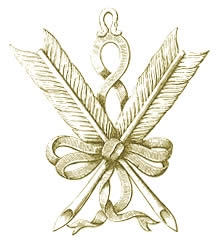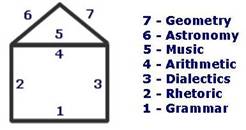 The Secretary – The Master of Ceremonies – Gloves and Apron (the importance of colors) – The Seven Liberal Arts The Secretary – The Master of Ceremonies – Gloves and Apron (the importance of colors) – The Seven Liberal Arts
It will be useful to make some considerations on the tasks that the Secretary (Secr.) carries out in his Lodge Activity, which are known to every Br. The first divine scribe of the Temple, which is not known to our western culture (from Persians up till now), is the God Thoth, the divine Scribe of the Gods. On an operative level the Secr. is receptive inside the Temple, whilst outside he is its messenger; Thoth was the messenger of Gods, the Secr. is the messenger of the will of the Lodge, which is synthesized in the figure of the W.M. or the Three Lights.
The esotericism of certain Masonic jewels and paraments
by Adriano Nardi
© copyright by Esonet.it - Esonet.com

Dedicated to Athos A. Altomonte's work of instruction
Index : The Secretary – The Master of Ceremonies – Gloves and Apron (the importance of colors) – the Seven Liberal Arts
The Secretary
It will be useful to make some considerations on the tasks that the Secretary (Secr.) carries out in his Lodge Activity, which are known to every Br.  The first divine scribe of the Temple, which is not known to our western culture (from Persians up till now), is the God Thoth, the divine Scribe of the Gods – which is what we call the Greater Incognitos, or what was then called Hierarchy. The first divine scribe of the Temple, which is not known to our western culture (from Persians up till now), is the God Thoth, the divine Scribe of the Gods – which is what we call the Greater Incognitos, or what was then called Hierarchy.
By studying this figure we will be able to verify that the emblem of the God Thoth was an eagle. Strangely, instead of having two styles, the Secr. has two feathers on his jewel; it would be interesting to find out if they are a unique heritage or a new acquisition, because in the former instance it could be a precise reference to the God Thoth.
On an operative level the Secr. is receptive inside the Temple , whilst outside he is its messenger; Thoth was the messenger of Gods, the Secr. is the messenger of the will of the Lodge, which is synthesized in the figure of the W.M. or the Three Lights.
If we look back at the Greek culture, we find the same figure of messenger of the gods in Hermes Trismegistus (three times great), represented by Mercury, which didn't have an eagle as his symbol, nor feathers, but the Caduceus of Hermes (see Men who want ‘Wings' ). You know how important this symbol is on an initiatory level; it contains in itself the whole sense of the Great Work (from the Tree of the Sephiroths to the floor of the Temple , to the energetic centers of man).
The Master of Ceremonies
When we detachedly observe the work of the Master of Ceremonies (M.o.C), the role that we can immediately acknowledge to him is the ‘servant', the man who serves. But thinking about this hypothesis, it follows that we should compare him to a sacristan , not to a Priest, therefore this can't be his role. Indeed, The M.o.C. is not a servant, nor a sacristan, but the true Magician.
His jewel is Saint Andrew's Cross. The esoteric reading of the energetic motion that he should govern is recognizable in the symbol of the Mobile Cross, which represents the life of form and personality, metaphorically expressed by the ‘ ascending the Wheel ' of manifestation. The Mobile Cross finds its correspondence in the degree of Apprentice.
The inner work of the Apprentice brother should lead him to focus on a Fixed Cross. This is also remembered as ‘ preparation to the second Birth '; it symbolizes the cycle of discipleship, viz. the development of the soul through personality. The Fixed Cross finds its correspondence in the degree of Fellow Craft.
You will wonder how to stop a cross. Using a metaphor we could say: how do you stop a ‘merry-go-round'? Perhaps from the point of view of the most external circumference, where the drive is greater? That is from the profane world, restraining impulses such as sex, greed, avidity, egoism. Nothing of the kind; it is possible to stop the cross only by focusing on the inside.
This is the symbol of the conscience that focuses where there is less resistance; this work will lead the adept to go from the Mobile to the Fixed Cross. To talk about the Fixed Cross and about Crosses in general means to open a huge question that for the moment doesn't concern us, other than remembering its presence in the symbology of the Temple and of rituals. |



|
The M.o.C. is not the man who, with his conscience, restrains his own mobility, but he who restrains and directs the mobility of the Lodge. This is why he can't be a servant but the true Magician.
Before stopping this ‘wheel', we should make it move in a positive motion. The negative motion is anticlockwise, towards the left hand; the positive motion is clockwise. The latter is known in the East, in Tibet , as well as in the West by north-American tribes, as the swastika.

The swastika is the symbol of the Sun. The Mobile Cross that moves without discipline must be kept by will and moved towards the East, the Light, not towards the West, the sunset, the Darkness.
This symbolism is also linked to the subject treated elsewhere; if us westerners, mentally active, not very contemplative, can't stop the mind (see concentration, meditation, visualization), we should tie it to the cart of a good deed, a positive goal; at this point it could move but at the same time we work creating an order.
The M.o.C. is the focal point of the Lodge and he must move its energies, therefore the energies of the brothers. In the Temple there are two energies: one belongs to the members themselves, the other to the Eggregore, the psychic thought-form that is expressed inside the Temple .
The man who works as an M.o.C. makes precise gestures and by carrying them out on the floor he enters in synergy with the energies that this symbol hides (see Imago Templi 2). He needs to gradually go from a state of torpor and unconsciousness, when reproducing certain gestures which haven't been mastered and understood yet, to a state of conscious and aware work.
For example, when the M.o.C. knocks on the Lodge Picture, he doesn't do it because he wants to produce a sound, but because he knows he must carry out this action. When this is done in conscience, using the mind, the result will be altogether different, because the energy follows the thought.
If one performs an action with the spiritual conscience as well as with the mental one, he will act in the physical and psychical plane as well as in the subtle kingdom.
This is the power of the Initiate who can move on several levels. If every action corresponds to a similar and opposite reaction, we can imagine the power of the reaction when we operate on four levels.
For the Man of the Temple, if the Orator corresponds to the center of the throat and the Secretary is the eye that sees, therefore receptive, the Master of Ceremonies is Tipheret, the heart, the cardiac center of the Temple, indeed he is the ‘energetic balancer of the Lodge'.
Gloves and Apron (the importance of colors)
They are both necessary elements for the work in the Temple .
The white gloves remind us of the moral cleanliness necessary to pass the threshold of initiation, viz. the first of the systems necessary for this purpose, which is the purification of the lower vehicles.
The apron is even more necessary than the gloves to work in the Temple .
The cordon (string or belt) has always been used and even nowadays several sacerdotal orders wear it. It indicates, or rather separates the upper part from the bottom part. The area below, with its energetic centers, is necessary for the evolutionary purposes on the physical planes, through the procreation and the reproduction of other forms. This need disappears in the development of the superior planes, viz. mental, psychic and spiritual.
Therefore the cordon separates this area and by tightening it, one has the feeling of having to bring his conscience further up. When we enter the Temple and tie the apron we carry out an important symbolic gesture, because we want to prevent our conscience from flowing towards the bottom and our instincts from flowing towards the top. When this condition is consciously applied, it generates a psycho-conscience attitude definitely different from the usual one in the profane world.
The cordon also reminds us of the chastity string that warriors and priests used to wear; the solar plexus, energetic center that synthesizes the highest part of the man-animal, seat of personality , stays above the cordon. The conscience brought and focused in this center becomes first initiation . This statement involves the fact that the ‘animal' must be sublimated and transmuted, not ‘killed' as it is often inconsiderately said. Indeed ‘to kill' the animal means to lose the ‘instrument', which on the contrary must be educated in order to be able to express a temperament that synthesizes the virtues of the three lower vehicles (physical, emotional, mental) leaving impulses, low instincts and all that is pos-session (see note) below the cordon.
(note: In Italian the word "possesso" (possession) is made of pos- and –sesso (sex), meaning that sex is included in the concept of possession)
All the initiatory fittings and clothing have something in common: they should reproduce on the physical plane a color, which the officer would emit himself if he is in the right elevation of conscience.
Let's take the example of the miter; the man who wears this headgear could be a pope, a cardinal, or in any case a high rank officer; if he actually was an initiate of the level indicated by the paraments, viz. to justify this degree (not just officially), from a clairvoyant point of view he would emit from the center of his head an energy that flows to the top, exactly like the shape of the miter suggests. Even pharaohs wore this headgear adorned with a snake, which represented the opening of the Third Eye. This is an occult memory and a teaching for those who are aware that we are not an initiated bishop or an initiated pharaoh but only officially initiated.
The concept we want to highlight is that the color worn by man is an allegorical refraction of what this color should actually be; if I don't emanate this color, but I visualize it through the physical color and I think about it, something starts actually moving.
This explains the black color in the apron, which acts on the ‘lower part', since it is placed on the most physical of all senses, the genitals – Scorpio in the astrological sense – with the function of ‘calming' this center; it works by expressing its essence represented in the work of Putrefaction , the silencing of all the colors that stops everything. In order to understand how this happens, that is how the action of the color can affect the field of forces that manifest a highlighting of conscience rather than another, we should study the work of the schools that draw from an ancient knowledge, which uses color as the basis for healing. The field of investigation of colors is wide and fascinating and it must be dealt with elsewhere.
The apron is the emblem of work, because reminds us that the mason must always lead an active and laborious life on a moral level.
The color white of the gloves reminds us of neatness, cleanliness and moral integrity; it generates a refraction on ourselves, which even leads us to small changes of thought. It is easily comprehensible that if I am in a dark and dull environment similar to a prison, a dungeon, it will affect my mood with similar dullness and sadness; if I am in a red environment, sooner or later the excitement will grow in a range that goes from anger to will to do, up to sexual excitement.
The color has always an unconscious effect on the psyche; if we understand this we will comprehend how important it is to visualize the right colors in order to obtain effects by our will and not by coincidence. This is a science.
Another color on the masters' apron is red; this represents the fire in its positive sense, igneous fire.
Traditionally this parameter is the symbol of Masonic work; on a speculative level we must start by considering the two geometrical forms contained in the apron: a triangle and a square.
Let's forget for a moment that it is an apron and let's analyze the reason why it is made in such a shape. The message conveyed is that the triangle represents the higher Triad, the soul, whilst the square indicates the lower Quaternary of the elements.
In the specific case, the lower side, the most physical, represents the Earth, as much as the higher side represents the Air element; the ascending and descending sides represent respectively Water and Fire. It follows that the square expresses the physical world. |

|
The Apprentice that enters the Temple has the triangular bib lifted, because the Spiritual Triad doesn't pervade the Personality yet.
In the degree of royal Fellow (we are not on the level of Ars Muratoria, but of Ars Regia) we have the penetration of the higher Triad in the lower Quaternary. |

|
In the first degree the Spiritual Triad is ‘detached' from Personality, which wanders alone in the profane world; through Instruction (the Masonic catechism says that we can go to the next degree only through knowledge ) we bring the attention of the Personality towards the top (symbolically speaking it would be more correct to say towards the inside), which draws the attention of the Triad towards the bottom, up to having a penetration of the latter with the former in the second degree. When this penetration occurs not only as attention but also as conscience, as fact, the initiate, in the third degree, is permeated by the fire of the soul and this is symbolized by the red hem of his apron.
The Seven Liberal Arts
If we consider a level for each side of the apron, we have seven levels.

In the meaning of these levels is the reason why the apron is necessary for the work in the Temple. Indeed, to know that the square represents the lower quaternary and the triangle the Spiritual Triad doesn't tell me how to become an initiate.
Everything originates from Instruction .
At the basis of Instruction there is study, recognition, research; if there isn't a rich and wide propriety of language there can't be communication or at least this would be poor and full of misunderstandings and false interpretations; we should elevate to the highest point of interpretation of a word, so much that we can't elevate any further; when we are at the top, if there aren't any interpretative ups and downs in the ‘group' there aren't any more mistakes, we always know that what we transmit is correctly interpreted.
The tower of Babel has its fundaments in the diversity of languages; people who understand the opposite of what is transmitted to them, who remember confusedly and fill concepts with inappropriate words, transmitting confusion, feeding chaos.
At the basis of everything, therefore, there is the knowledge of the language; I don't mean the Italian language, but just the language. From an authoritative dictionary, we quote the description of the word Grammar: study of the constituting elements (careful: it is not only language; we are very close to a mathematical idea) of a language: sounds, forms, words and syntax.
The syntax that we have learnt first of all is actually the last mentioned in the definition. A Mason or a person that wishes to elevate, therefore to be initiated, should stop and think that the language, therefore oratory, the creation of thought-forms through sound, goes through the knowledge of sounds, forms (it is important to remember that the sound is a form), words and syntax.
Other definition: it formulates the rules that the writer and the speaker must obey; the book that deals with this subject.
Rhetoric: art that tends to convince of fairness or unfairness (moral principle) , through the use of appropriate linguistic instruments; - technique of realization of expressive means also said of rhetoric figures.
Dialectics: art of discussion; art of reasoning; - ability in discussing; process where two contraries, thesis and antithesis, in thought or reality (depending if the subject is a theoretical, speculative or operative one) unitarily develop, resolving in a higher moment called synthesis (and we have now discovered on which level synthesis is).
Discussion as we know it is always from a dividing point of view, as polemics, contraposition of factors; we should know it from a constructive point of view, which is achieved through the art of discussion, through the study of thought-forms aimed at constantly supporting rather than competing.
Arithmetic: branch of mathematics that studies the properties of natural numbers ; indeed, we are not interested in mathematics in the sense of economical or financial calculation; we need the true astronomical, geometrical, and numerological aspect, therefore Arithmetic.
Therefore Grammar is the basis; without it there can't be Rhetoric; once we know the instrument and start using it, we reach Dialectics; then we go to the synthetic topic of numbers , because synthesis also means number; Arithmetic leads to Music: art of combining sounds according to defined rules (otherwise it would become cacophony).
Astronomy: science that studies the stars and celestial phenomena . At this level we find Harmonics of forms, sounds, colors, stars, the movement of planets, the interaction between physical and ethereal planets; this is the science of Harmonics .
Geometry: branch of mathematics that deals with the figures in a space; it studies the beings that can be represented in an algebraic form; geometry in the application between algebra and analysis; study of spatial representations on a plane; rigorous structure . Here the word ‘space' has been used twice; at the moment we partially agree with it, but later on we won't. Usually we mean the three-dimensional space, but we know that conceptually we can reach the eleventh dimension. It is true that we live in three dimensions, but on a conceptual level we have the instruments to reach the eleventh dimension. As many dimensions as many the spaces that our bodies occupy; therefore my body in height, width and thickness occupies three spaces, the astral part is the fourth, the mental body the fifth, etc…
The seven elements we have mentioned, which going from the bottom to the top are Grammar, Dialectics, Arithmetic, Music, Astronomy and Geometry, are called the Seven Liberal Arts . These are the seven arts through which the Mason can understand his own vehicle of initiation.
|


